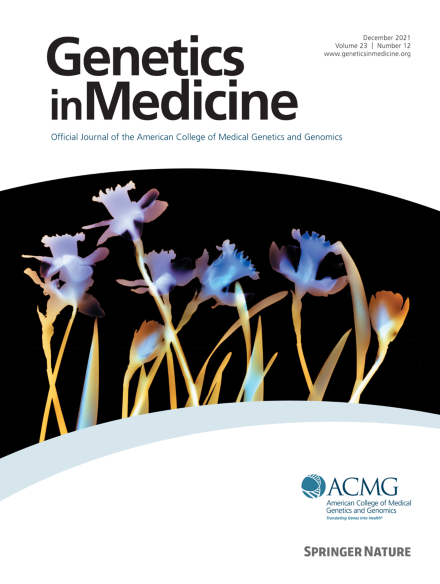Upregulation versus loss of function of NTRK2 in 44 affected individuals leads to 2 distinct neurodevelopmental disorders
IF 6.2
1区 医学
Q1 GENETICS & HEREDITY
引用次数: 0
Abstract
Purpose
Heterozygous pathogenic variants in NTRK2 (HGNC: 8032) have been associated with global developmental delay. However, only scattered cases have been described in small or general studies. The aim of our work was to consolidate our understanding of NTRK2-related disorders and to delineate the clinical presentation.
Methods
We reported an extended cohort of 44 affected individuals, of whom 19 are from the literature and 25 were previously unreported.
Results
Our analysis led to splitting the cohort into 2 entities.
Conclusion
One group had variants in the cholesterol-binding motif of the transmembrane domain, with most of these being the recurrent variant c.1301A>G p.(Tyr434Cys). These variants probably lead to upregulation of tropomyosin receptor kinase B activity and to a severe phenotype of developmental delay/intellectual disability, muscular hypotonia, therapy-refractory epilepsy, visual impairment and blindness, and feeding difficulties. The second group had truncating variants or variants that presumably disturb the 3D structure of the protein leading to loss of function. These individuals had a remarkably milder phenotype of developmental delay, obesity, and hyperphagia.
在 44 个受影响的个体中,NTRK2 的上调与功能缺失会导致两种不同的神经发育障碍。
导言NTRK2(HGNC:8032)的杂合子致病变异与全球发育迟缓有关。然而,在小型或一般性研究中,只有零星的病例被描述过。我们的工作旨在巩固我们对 NTRK2 相关疾病的认识,并描述其临床表现 方法:我们报告了由 44 例受影响个体组成的扩展队列,其中 19 例来自文献,25 例此前未曾报道:结果:通过分析,我们将人群分为两组:讨论:其中一组患者的跨膜结构域的胆固醇结合基序存在变异,其中大部分为复发性变异 c.1301A>G p.(Tyr434Cys)。这些变异可能会导致 TRKB 活性上调,出现发育迟缓/智力障碍、肌肉张力低下、治疗难治性癫痫、视力障碍和失明以及喂养困难等严重表型。第二组患者有截短变异或变异,这些变异可能扰乱了蛋白质的三维结构,导致功能丧失。这些人的发育迟缓、肥胖和多食的表型明显较轻。
本文章由计算机程序翻译,如有差异,请以英文原文为准。
求助全文
约1分钟内获得全文
求助全文
来源期刊

Genetics in Medicine
医学-遗传学
CiteScore
15.20
自引率
6.80%
发文量
857
审稿时长
1.3 weeks
期刊介绍:
Genetics in Medicine (GIM) is the official journal of the American College of Medical Genetics and Genomics. The journal''s mission is to enhance the knowledge, understanding, and practice of medical genetics and genomics through publications in clinical and laboratory genetics and genomics, including ethical, legal, and social issues as well as public health.
GIM encourages research that combats racism, includes diverse populations and is written by authors from diverse and underrepresented backgrounds.
 求助内容:
求助内容: 应助结果提醒方式:
应助结果提醒方式:


